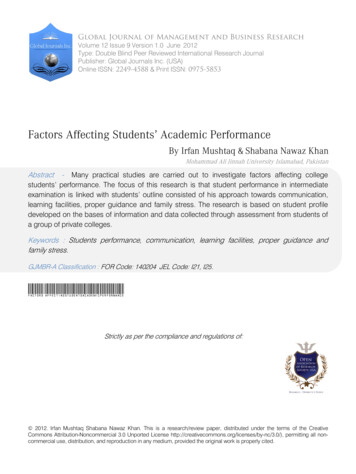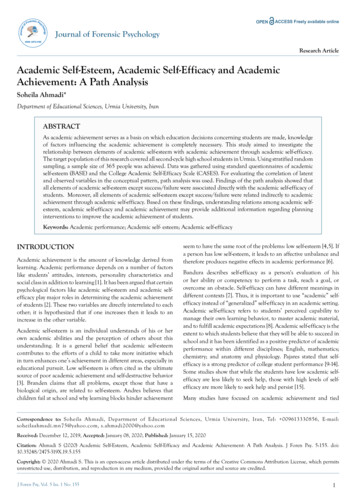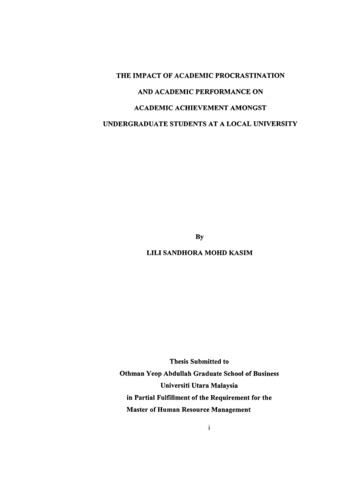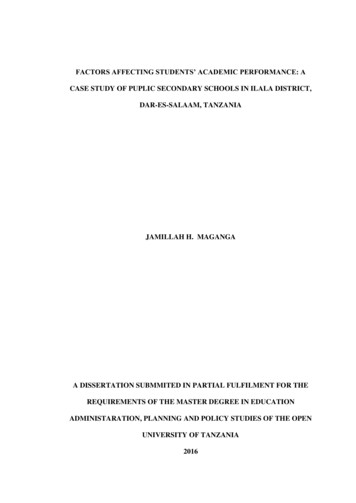
Transcription
Global Journal of Management and Business ResearchVolume 12 Issue 9 Version 1.0 June 2012Type: Double Blind Peer Reviewed International Research JournalPublisher: Global Journals Inc. (USA)Online ISSN: 2249-4588 & Print ISSN: 0975-5853Factors Affecting Students’ Academic PerformanceBy Irfan Mushtaq & Shabana Nawaz KhanMohammad Ali Jinnah University Islamabad, PakistanAbstract- Many practical studies are carried out to investigate factors affecting collegestudents’ performance. The focus of this research is that student performance in intermediateexamination is linked with students’ outline consisted of his approach towards communication,learning facilities, proper guidance and family stress. The research is based on student profiledeveloped on the bases of information and data collected through assessment from students ofa group of private colleges.Keywords : Students performance, communication, learning facilities, proper guidance andfamily stress.GJMBR-A Classification : FOR Code: 140204 JEL Code: I21, I25.Factors AffectingStudentsAcademicPerformanceStrictly as per the compliance and regulations of: 2012. Irfan Mushtaq Shabana Nawaz Khan. This is a research/review paper, distributed under the terms of the CreativeCommons Attribution-Noncommercial 3.0 Unported License http://creativecommons.org/licenses/by-nc/3.0/), permitting all noncommercial use, distribution, and reproduction in any medium, provided the original work is properly cited.
Factors Affecting Students’ AcademicPerformanceKeywords : Students performance, communication,learning facilities, proper guidance and family stress.I.IntroductionSchool, colleges and universities have no worthwithout student. Students are most essential assetfor any educational institute. The social andeconomic development of the country is directly linkedwith student academic performance. The students’performance (academic achievement) plays animportant role in producing the best quality graduateswho will become great leader and manpower for thecountry thus responsible for the country’s economic andsocial development (Ali et.al, 2009). Student academicperformance measurement has received considerableattention in previous research, it is challenging aspectsof academic literature, and science student performanceare affected due to social, psychological, economic,environmental and personal factors. These factorsstrongly influence on the student performance, but thesefactors vary from person to person and country tocountry.From the last few years in Pakistan literacy rateand education improved and most of the instituted inPakistan improving the educational level and producewell educated, competitive and skilled person, thosemeet dynamic growing market requirement. That’s areason the researcher find out such factors that effectingstudent performance, especially in rural areas wherestudent face lot of problem.Previously mostly study of student academicperformance conducting on such issues like genderdifference, teacher’s education and teaching style, classenvironment, socio economic factor and familyeducation background. The finding of this study variesAuthor Į : MS Scholar, Mohammad Ali Jinnah University IslamabadPakistan. E-mail : irfan.mushtaq08@gmail.comAuthor ı : M. Phil Scholar, Faculty of Administrative Sciences Kotli,University of Azad Jammu & Kashmir Muzaffarabad, Pakistan.E-mail : dj96.snkhan@gmail.comfrom region to region and their results differ in cities andrural areas.This research is focuses on the private collegesin Pakistan. Students of private colleges of Rawalpindiand Islamabad are taken as population and focuses onthe result of the student performance and theirachievements in the academic year.Wemeasurethestudentacademicperformance through several ways like CGPA, GPA andtheir test result. Most of the researcher around the wordused the GPA to measure the student performance(Galiher, 2006; Darling, 2005; Broh, 2000; Stephen &Schaban, 2002). They used GPA to measure studentperformance in particular semester. Some otherresearcher, they measure student performance throughthe result of particular subject or the previous year result(Hijazi & Naqvi, 2006; Hake, 1988; & tho.1994).II.SignificancePrevious studies focuses on different factorssuch class schedules, class size, English text books,homework, environment of the class, technology used inthe class and exams systems, extracurricular activities,family and work activities, financial, and etc. The studymay helpful for both college’s policy makers andparents of the students. It helps the collegeadministration to design and implement the policies toimprove the students’ performance and the quality ofeducation by changing the attitude of students towardslearning, facilitating students and improving the teachingprocedures. Parents can use the outcomes of the studyto solve the students’ problems especially financialproblems and to look after them. It may also createawareness among students about their rights andresponsibilities to achieve quality education.III.Research QuestionWhat are the important factors that affectstudents’ academic performance?IV.Research ObjectivesThe objective of this research paper is toexplore the important factors that affect the academicperformance of the students. 2012 Global Journals Inc. (US)17Global Journal of Management and Business Research Volume XII Issue IX Version I- Many practical studies are carried out toinvestigate factors affecting college students’ performance.The focus of this research is that student performance inintermediate examination is linked with students’ outlineconsisted of his approach towards communication, learningfacilities, proper guidance and family stress. The research isbased on student profile developed on the bases ofinformation and data collected through assessment fromstudents of a group of private colleges.AbstractJune 2012Irfan Mushtaq Į & Shabana Nawaz Khanı
Factors Affecting Students’ Academic PerformanceContributionJune 2012V.Global Journal of Management and Business Research Volume XII Issue IX Version I18Previously a lot of research has been done onthis topic. Different researchers researched on variousvariables and a lot of different variables were studied.This research is different in a way that it is the firstresearch in which a variable “proper guidance” isstudied, moreover in Pakistan only one research wascarried out on this topic and it was conducted by AbidHussain in 2006 and that too was based on the findingsof school’s whereas this research is conducted oncolleges.Our contribution to this study is that we explorethe four factors that affect students’ unication skills, learning facilities, proper guidanceand family stress. In Pakistan scenario, manyresearchers have done a lot of work on communication,learning facilities and family stress.This research will be helpful for the parents aswell as the teachers of the students to guide themproperly and as per their abilities.VI.Literature Reviewa) Student PerformanceGaliher (2006) and Darling (2005), used GPA tomeasure student performance because they main focusin on the student performance for the particularsemester. Some other researchers used test results orprevious year result since they are studying performancefor the specific subject or year (Hijazi and Naqvi, 2006and Hake, 1998).b) CommunicationMany researchers has been discussed thedifferent factors that affects the student academicperformance in their research. There are two types offactors that affect the students’ academic performance.These are internal and external classroom factors andthese factors strongly affect the students’ tscompetence in English, class schedules, class size,English text books, class test results, learning facilities,homework, environment of the class, complexity of thecourse material, teachers role in the class, technologyused in the class and exams systems. Externalclassroom factors include extracurricular activities,family problems, work and financial, social and otherproblems. Research studies shows that students’performance depends on many factors such as learningfacilities, gender and age differences, etc. that canaffect student performance (Hansen, Joe B., 2000).Harb and El-Shaarawi (2006) found that the mostimportant factor with positive effect on students'performance is student's competence in English. If thestudents have strong communication skills and havestrong grip on English, it increases the performance of 2012 Global Journals Inc. (US)the students. The performance of the student is affectedby communication skills; it is possible to seecommunication as a variable which may be positivelyrelated to performance of the student in open learning. Amajor distinction of this study from previous studies isthat it focuses on open learning (Abdullah AL-Mutairi,2011).H1: There is a positive relationship betweencommunication and student performance.c) Learning FacilitiesKaremera (2003) found that students'performance is significantly correlated with satisfactionwith academic environment and the facilities of library,computer lab and etc. in the institution. With regard tobackground variables, he found a positive effect of highschool performance and school achievement he foundno statistical evidence of significant association betweenfamily income level and academic performance of thestudent.Robert & Sampson (2011), found that themember of educational board will be educated and theirimpact on school is positive, for professionaldevelopment it is essential for student learning.The students who are actively engage in thelearning process are observed to have a positivecorrelation with the CGP. A Study effort from studentand the proper use of the facilities provided by theinstitution to the student, a good match betweenstudents’ learning style and are positively affect thestudent's performance (Norhidayah Ali, et. al., 2009)Young (1999), held the view that studentperformances are linked with use of library and level oftheir parental education. The use of the library positivelyaffected the student performance.The academic environment is the effectivevariable for students and has positive relationship withfathers’ education and grade level (Kirmani & Siddiquah,2008).H2: There is a positive relationship betweenlearning facilities and student performance.d) Proper ents and activities, perceptions of theircoping strategies and positive attributions, andbackground characteristics (i.e., family income, parents’level of education, guidance from parents and numberof negative situations in the home) were indirectlyrelated to their composite scores, through academicachievement in high school.The students face a lot of problems indeveloping positive study attitudes and study habits.Guidance is of the factor through which a student canimprove his study attitudes and study habits and isdirectly proportional to academic achievement. Thestudents who are properly guided by their parents haveperformed well in the exams. The guidance from the
teacher also affects the student performance. Theguidance from the parents and the teachers indirectlyaffect the performance of the students (Hussain, 2006).H3: There is a positive relationship betweenproper guidance and student performance.e) Family StressSocio-economic factors like attendance in theclass, family income, and mother’s and father’seducation, teacher-student ratio, presence of trainedteacher in school, sex of student and distance of schoolare also affected the performance of the students.(Raychauduri et al., 2010)Kernan, Bogart & Wheat (2011), academicsuccess of graduate student will be enhanced if theoptimal health related barriers are low. There is negativerelationship between college credit and stress but weakrelationship between GPA (Grade Point Average) and19Theoretical FrameworkCommunicationLearning FacilitiesStudents PerformanceProper GuidanceFamily StressVIII.MethodologyThis section discusses the sample selectionprocedure, variables selection, the model used for theresearch and the statistical techniques.a) MeasuresThe extent of existence for all variables in theresearch area was measured on a five-point likert scaleranging from, strongly disagree to Strongly Agree.Ranging from 1 to 5 Strongly Disagree (1),Disagree (2), Neutral (3), Agree (4), Strongly Agree (5).b) Data SetThe source of data for this study is primary dataacquired through questionnaire. 175 questionnaireswere distributed.c) Statistical ToolsMean, Standard deviation, correlation andregression analysis are used through appropriatestatistical package.IX.Results And ConclusionFindings of the study are discussed as under.a) Data Analysis and DiscussionIn order to meet the purpose of the study, thissection has five parts for analyzing the data collected forthe study. TheFive parts are: (a) data sample information, (b)descriptive analysis, (c) correlation analysis, (d)regression analysis and (e) Hypothesis testing.b) Reliability of the ScaleReliability of total Items is 0.710 in Table 1 whichshows its significance.c) Reliability of Total ItemsTable 1 : Reliability StatisticsCronbach's AlphaN of Items.71020Reliability of Individual Items is shown in Table 2. 2012 Global Journals Inc. (US)Global Journal of Management and Business Research Volume XII Issue IX Version IVII.stress. (Zajacova, Lynch and Espenshade, 2005)Amitava Raychaudhuri, et. al., (July 2010),found that numerous studies have been done to identifythose factors which are affecting student’s academicperformance. The students’ academic performancedepends on a number of socio-economic factors likestudents’ attendance in the class, family income,mother’s and father’s education, teacher-student ratio,presence of trained teacher in school, sex of thestudent, and distance of schools.Hijaz and Naqvi (2006) observed that there is anegative relationship between the family income andstudents’ performance and they focus on the privatecolleges in Pakistan.H4: There is a negative relationship betweenfamily stress and student performance.June 2012Factors Affecting Students’ Academic Performance
Factors Affecting Students’ Academic PerformanceTable 3 : Descriptive Statisticsd) Reliability of Individual ItemsTable 2June 2012VariablesGlobal Journal of Management and Business Research Volume XII Issue IX Version I20Cronbach's AlphaNo.of ning Facilities.7354ProperGuidance.8063Family Stress.2586NMinimum Maximum MeanStudent155PerformanceCommunication 155Learning155FacilitiesProper155GuidanceFamily Stress 155Valid N155(listwise)Descriptive AnalysisDescriptive statistics represents the calculatedmeans and standard deviations for the dependentvariables, communication, learning facilities, properguidance and family stress and independent variable,student performance.Study shows that mean of student performanceis 3.7903 and standard deviation is .98672.Mean of communication, learning facilities,proper guidance and family stress are 4.1626, 4.2597,4.1462 and 4.28172 respectively, which shows thatrespondent are agree that these variables effect studentperformance and standard deviation for theseindependent variables are 0.50390, 0.67713, 0.89659and 0.396398 respectively., which is shown in Table 3:1.005.003.7903 .986721.201.255.005.004.1626 .503904.2597 .677131.005.004.1462 .896593.1675.0004.28172 .396398Demographic Analysis: Demographic results wereobtained. The total sample size was n AnalysisThere is a degree of association betweencommunication and student performance i.e. 13 percentand also shows negative value and probability of error isalso low.There is degree of association between learningfacilities; proper guidance and family stress with studentperformance are 13 percent, 20 percent and 2 percentrespectively as shown in Table 6.Table 6 : CorrelationsStudentLearningPerformance Communication FacilitiesStudentPearson CorrelationPerformanceSig. (2-tailed)NCommunicati Pearson CorrelationonSig. on Correlation.137.157Sig. 5155155155**1155Pearson Correlation*.200.176.571Sig. 055.498155155155155155-.020.139.245**.0551Sig. (2-tailed).809.085.002.498N155155155155Family Stress Pearson Correlation*. Correlation is significant at the 0.05 level (2-tailed).**. Correlation is significant at the 0.01 level (2-tailed). 2012 Global Journals Inc. Std.Deviation155
Factors Affecting Students’ Academic Performancee) Regression AnalysisModel SummaryModel summary is shown in Table. Value of RSquare is .0553 shows that 55% variation in studentperformance due to the independent variablescommunication, learning facilities, proper guidance andfamily stress.Model SummaryModel1R.229aAdjusted RSquareR Square.553.427Std. Error ofthe Estimate1Regression 7.8894MeanSquare F1.972Residual142.046 150 .947Total149.935 154Sig.20.083 .026aa. Predictors: (Constant), Family Stress, Proper Guidance,Communication, Learning Facilitiesb. Dependent Variable: Student PerformanceF-statistics were carried out to find the overallstrength of the model. The value of F-Statistic 20.083shows that the model is highly significant shown inTable 8.0.0021a. Predictors: (Constant), Family Stress, ProperGuidance, Communication, Learning Facilities21Table dardizedCoefficientsBStd. 1.279 .003Learning Facilities.160.146.041.413Proper Guidance.177.108.1611.642 .103Family Stress-.132.207-.053-.638BetatSig.2.423 .017.020.524a. Dependent Variabl e: Student Performanceg) Coefficient & Hypothesis TestingOn the basis of Beta coefficients the modelshows that communication causes 20% positivevariation in student performance and t -value is alsosignificant. . So we accept H1 which states that “there ispositive relationship between communication andstudent performance.Learning facilities causes’ 16% variation instudent performance but the direction is positivedirection. Here t-value is also significant. So we acceptH2 which states that that “there is positive relationshipbetween learning facilities and student performanceProper guidance causes 17% variation in studentperformance in positive direction and t – value is alsosignificant. So we accept H3 which states that that“there is positive relationship between proper guidanceand student performanceFamily stress causes 13% variation in studentperformance but in opposite direction or negativedirection and t – value is insignificant. So we reject H4which states that “there is negative relationship betweenfamily stress and student performance.X.DiscussionThis study was conducted to explore theimportant factors that affect the students’ academicperformance. Research was conducted on privatecolleges in Rawalpindi and Islamabad. Four hypothesisused in the study to check the effect of independentvariables on dependent variables. By using theappropriate statistical package it is found thatcommunication, learning facilities, proper guidance andfamily stress are the factors that affect the studentperformance. Our three hypotheses are accepted andone hypothesis is rejected. Communication, learningfacilities and proper guidance shows the positive impacton the student performance and the family stress showsthe negative impact on the student performance but thesignificant level is high. So, it is indicated that thecommunication is more important factor that affect thestudent performance and the learning facilities andproper guidance are also affect the studentperformance. Family stress also affects the studentperformance and reduces the performance of thestudent and affects negatively the student performance.a) LimitationsxJune 2012f)Sum ofSquares dfModelThere are certain limitations of this study. Firstly, thesample size taken in this study was very small that isonly 155. If this study is being carried out again withlarge sample size the result might be improved thanexisting study. 2012 Global Journals Inc. (US)Global Journal of Management and Business Research Volume XII Issue IX Version IIt includes Model Summary and ANOVA andCoefficient.Table 7 : ANOVAb
Factors Affecting Students’ Academic PerformancexxSecond limitation of the study was that studyconducted on only thein the 2 cities of Pakistan i.e.,Rawalpindi and Islamabad.Including more others relative factors that affect thestudent performance can improve the results.b) Suggestions and RecommendationsxJune 2012xGlobal Journal of Management and Business Research Volume XII Issue IX Version I22xThe student performance should be improve if theadministration of the college provides properleaning facilities to the students and also improvethe environment of the college.The student performance should be improve if thestudents have good and effective communicationskills and have good competence in English. Forthis the administration should take steps to arrangethe class for the English language.The student should perform well if they are properlyguided by the parents and also by their teacher. Ifthe student should know well about their abilitiesand their competences then he performs well.References Références Referencias1. Ali, Norhidayah, Jusoff, Kamaruzaman, Ali, Syukriah,Mokhtar, Najah and Salamt, Azni Syafena Andin. (20December 2009). ‘The Factors Influencing Students’Performance at Universiti Teknologi MARA Kedah,Malaysia’. Canadian Research & DevelopmentCenter of Sciences and Cultures: Vol.3 No.4.2. AL-Mutairi, Abdullah. (May 2011). ‘Factors AffectingBusiness Students’ Performance in Arab OpenUniversity: The Case of Kuwait’. InternationalJournal of Business and Management: Vol. 6, No. 5.3. Barkley, Andrew. (June 12, 2006). ‘TheDeterminants of College Student Performance: TheRole of Assessment Method’. WAEA annualmeetings.4. Cheesman, Jennifer, Simpson, Natalee and Wint,Alvin G. (March 22, 2006). ‘Determinants of StudentPerformance at University: Reflections from theCaribbean’.5. Diaz, Antonia Lozano. Personal, Family AcademicFactors Affecting Low Achievement In SecondarySchool. Electronic Journal of Research inEducational Psychology and Psychopedagogy,1(1), 43-66. ISSN: 1696-2095.6. Double, Niharika & Supriya., M, V. (2011). StudentLife Balance: Myth or reality? The InternationalJournal of Educational Management, vol.25, NO.3,pp.237-251.7. Hijazi, Syed Tahir and Naqvi, S.M.M. Raza. (January2006). ‘Factors Affecting Students’ Performance: ACase of Private Colleges’. Bangladesh e-Journal ofSociology: Volume 3, Number 1.8. Harb, Nasri and El-Shaarwi, Ahmed. (July 2006).‘Factors Affecting Students' Performance’. MPRAPaper No. 1362. 2012 Global Journals Inc. (US)9. Hussain, Ch. Abid. (June 2006). Effect of GuidanceServices on Study Attitudes, Study Habits andAcademic Achievement of Secondary SchoolStudents. Bulletin of Education and Research, vol.28, No. 1 (35-45).10. Kernan, Willium, Bogart, Jane & Wheat, Mary E.(2011). Health related Barriers to learning amonggraduate student, Health Education, vol. 11,NO. 5,pp.425-455.11. Kirmani, Neghat Sana & Siddiquah, Aishah(December 2008). Identification and Analysis ofFactors Affecting Students Achievement in ing quality in higher education.12. Littlewood, W. (1984). Foreign and SecondLanguage Learning. Cambridge University Press.13. Noble, Julie P., Roberts, William L. and SawyerRichard L. (October 2006). ‘Student Achievement,Behavior, Perceptions, and Other Factors AffectingACT Scores’. ACT Research Report Series 2006 - 1.14. Poropt, Arthur E. (2011).The eysenckain PersonalityFactors And their correlation with ology,81,pp.41-58.15. Raychaudhuri, Amitava, Debnath, Manojit, Sen,Seswata & Majundra, braja Gopal. (2010). Factorsaffecting Student’s academic performance: A casestudy in agartala municipal concial area.Bangladesh e-journal of sociology, vol.7, Number.2.16. Roberts, Kerry L. & Sampson, Paulinen M.(2011).School board member professional developmentand effect on student achievement. InternationalJournal of Educational Management, vol.25, NO.7,pp.701-713.17. Raychaudhury, Amitawa., Debnath, Manojit., Sen,Saswata & Majumder, Braja Gopal. (July 2010).Factors Affecting Students’ Academic Performance:A Case Study in Agartala Municipal Council Area.Bangladesh e-journal of Sociology, Vol. 7, No. 2.18. Saenz, terry, Marcoulides, George A., Jum, Ellen &Young, Ray. (1999). The relationship betweencollege experience and academic performanceamong minority student. The International Journal ofEducational Management, pp.199-207.19. Weymer Richard A. (Spring 2002). Factors AffectingStudents’ Performance in Sixth Grade ModularTechnology Education. Journal of TechnologyEducation, Vol. 13, No. 2.20. Zajacova, Anna, Lynch, Scott M. & Espenshed.Thomes J. (2005). Self-Efficacy and academicsuccess in college.Reasearch in Higher Education,vol.40, NO.6, pp.677-706.
relationship between college credit and stress but weak relationship between GPA (Grade Point Average) and stress. (Zajacova, Lynch and Espenshade, 2005) Amitava Raychaudhuri, et. al., (July 2010), found that numerous studies have been done to identify those factors which are affecting student's academic performance.










